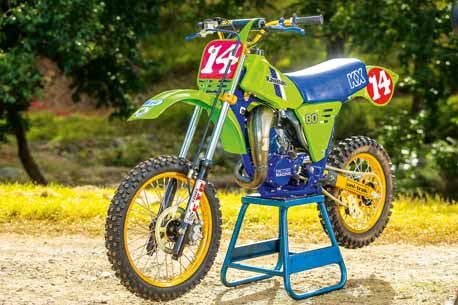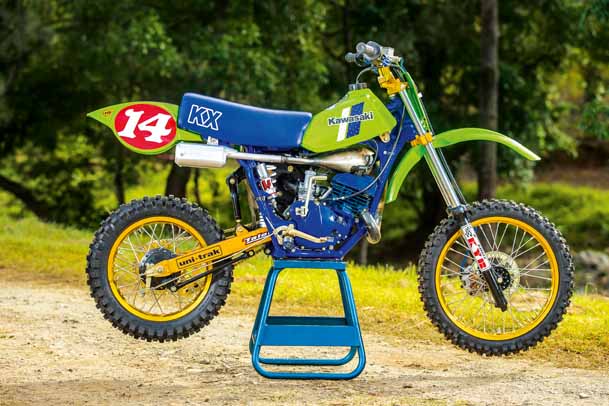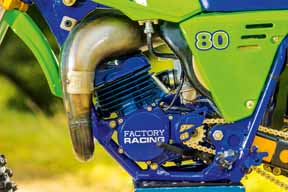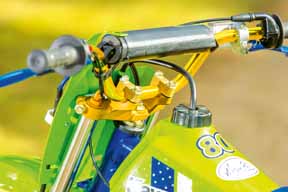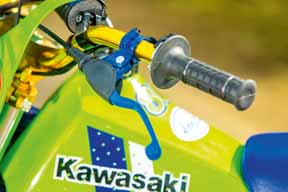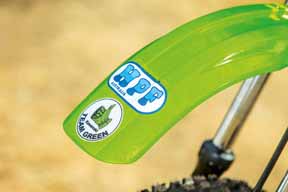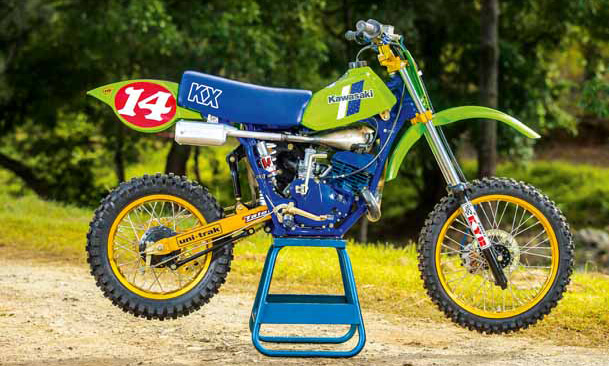
John Hafey takes on a rebuild mission with more twists and turns than the average MX track
WORDS & PHOTOS GREG SMITH/iKAPTURE
Those in the industry will know John Hafey and that he works for Husqvarna Motorcycles Australia. The thing most people don’t know is that he’s an avid collector of road and off-road motorcycles, among other things. You can find him at the national motocross races and other events but his passion is getting out and about on one of his many collectable motorcycles at a vintage motocross meeting.
I caught up with John at the recent Classic Dirt number 12 held this year at Queensland’s Green Park MX course. He wasn’t hard to find, lounging around on a mid-70s dragster pushbike close to his pride and jewels, all parked perfectly in line under his six-by-three tent.
I immediately noticed the KX80 and how beautifully it had been restored and asked if I could shoot it. He said yes and started telling me the story below. Trust me, if you want to know anything about these early-80s minibikes, there’s no one else to talk to.
BACKGROUND
Back in late 1981, I’d been racing for a little while on an RM50 when the time came to graduate to the 80cc class. My parents, who in hindsight probably couldn’t afford this sport with four children, recognised my single-minded love of motorcycle racing and decided to encourage it. One Thursday shopping night they ventured into town (Toowoomba) and toured the four main dealerships at the time with no real idea other than I needed an 80.
The story they recounted from that night I’ve never forgotten and use it in my role now. After, as they described it, not really getting much assistance anywhere else on the way home they dropped into the Kawasaki shop, Royal Kawasaki, which was a little out of the way, and were sold a brand new KX80D1 by a “very nice, helpful man”.
My journey started here as this man became a mentor and second father to me from that day. Noel Royal was a professional and passionate businessman who spent an amazing amount of time with me over the next 10 years, particularly during the recession years of 1984–85 when Dad was working seven days a week getting our family’s financial position back in order. I rode Kawasaki from this time until 1992, when a change of class in road racing brought about my first brand change.
I also made some lifelong friends during this period of Team Green “brotherhood”, such as Rohan Pask and Chris Hill. Noel continued to be there for me and my family right up until his premature death from motor neurone disease some 10 years back. My only regret is I didn’t call him more often for advice during my 20s, when I “knew everything” — and I certainly wish he was still around today as this lifetime motorcycle journey continues.
THE BIKES
Around eight years ago I went to an MX track in northern NSW with a much younger Dean Ferris for a weekend ride — a venue I’d not been to since 1982 for a school on this very KX. While I was soaking up the nostalgia, Dean showed me a small collection of unrestored bikes nearby. Right in front of me was a KX80D2.
Those in the know will understand my excitement given the comparative rarity of these machines. I expressed my need to own this bike. Four years ago, during my second tenure at McLeod Accessories, I employed Nathan Crawford who was having a tough time personally during this period (Nathan now works alongside me at Husqvarna Australia). Nathan was quite close to the owners of this northern NSW venue and I mentioned there was a KX80 there I really wanted to own.
Not one week later, Nathan turned up with not one but two KX80s, one even rarer in that it was a 1981 KX80D1, the same as my first 80. I won’t go into the details of the deal; however, many thanks go out to John Boyd and Nathan for making this a reality.
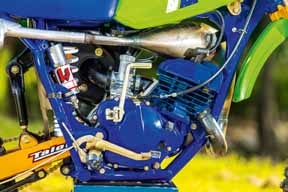
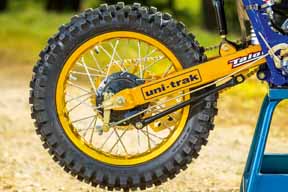
TWO PROJECTS
Early on I decided to restore the D1 back to showroom and display it in our house. It was very original, with original tyres, grips etc — just very, very rusty and no plastic at all. It must have spent 20 years in the weather.
The second project was going to be a rider (I don’t plan on growing up any time soon). The D2 was to become a “mini works replica”. I could see from some photos back in the day that such a bike existed in the United States under the Team Green program and I wanted to build one, only take it one step further.
STEP ONE: STRIP DOWN
After stripping the D2 down and consequently beginning the eBay parts chase, I took the frame and cases to my mate Geoff Holmes for a blast and a coat of “works blue”. I then bought a 1987 YZ80 front end off eBay as I liked the twin-piston caliper and disc arrangement on this bike. These bikes did not get disc front brakes until 1984 — true works bike. Geoff also did a beautiful job on the gold swingarm.
STEP TWO: BEGIN BUILD
Approximately 18 months later, after a job change and moving cities, I began to build this bike with the newly gold zinc-plated bolts. Problem number one: the main Uni-Trak bolt hole was flogged out and I didn’t notice this upon strip-down — really difficult to get at and extremely hard to repair.
Much anguish followed. I decided to think about this and build the engine up first using my newly acquired 99cc factory cylinder kit: freshly painted cases in factory blue, NOS crankshaft from Sweden, a new clutch basket.
After some research I discovered a 2013 KX100 piston kit from the UK drops straight in. Perfect.
While finishing the bottom-end assembly, I slid the NOS cylinder on and discovered BIG problem number two: the D1 and D2 have different cases and cylinder bases — very slight but the boost ports are larger on the D2.
More anguish. My factory 99cc cylinder is D1 only and they are very rare birds. Not many people know this as the models look almost identical but actually differ in many, many ways. Most eBay sellers assume these models coincide. They don’t. That I learnt with so many more discoveries later.
Luckily for me, Kurt Percy from Full Throttle Motorcycles (top Husqvarna dealer) still has many old parts and bikes around from the original wrecking business he purchased. He knew what I was building and gave me a rolling chassis and bottom end from another D2. It was time to start again with a new frame and cases (both required some repair) then off to a local powder coater in Toowoomba for a coat of space blue, which is closer to the original factory navy colour but still not correct. I like it, though.
STEP 3: BEGIN AGAIN
After another six-month break due to disgust, disillusionment and finances, I began again. But now in my desperation to solve some of these mysteries I stripped down the D1 to educate myself. All theories proved to be correct and I now had two KX80 projects running alongside each other. eBay again turned up a NOS 82cc D2 cylinder (Aussie/UK models were 79cc).
In fact there were two, except the seller explained one was a strange blue colour with different porting and came from Michigan out of Eddie Warren’s dad’s shed. I couldn’t hit the “Buy It Now” button fast enough, feeling sick at the money I was spending and trying to explain the world’s most expensive KX80 build to my forever understanding wife.
The wheels went off to John Titman many months ago to be built up in factory gold with a NOS rear hub I also got from Sweden. Rear shock went to Andy Thomasen of ATR fame to build me a “factory shock” out of a Works Performance shock I got from the US on eBay to fit D1/D2.
MORE PROBLEMS
Engine in frame and swingarm in, wheels arrived and the rear wouldn’t fit. The D1 and D2 have different spacer arrangements and my NOS hub turned out to be for the rarer bird — of course it was.
Problem solved as I found the correct D1 spacer at CMSNL in Holland’s online. It’s the last one — lucky me. A part arrived in a few weeks with the right part number but there’s a crank seal in the packet as it had been labelled wrongly. A few more weeks pass and another pops up on eBay, this time in the USA. Fixed. The rear wheel is in. A special Talon sprocket was air-freighted from UK by Kev Titman.
BEGIN FRONT END FABRICATION
The YZ80 steering stem is nothing like the 1982 KX80 so I need to get a custom stem made. Jason Corney of JCR Developments and I go back a long way (Radars Team Yamaha and before that also). He used his machinist skills to fabricate it to fit. I spent days with my Dremel buzzing the original casting marks off the top and bottom clamps to give them that works smooth look, then re-blasted them. A1 anodising at Ormeau then anodised them gold for me. The two different colours are a result of the two different materials.
The forks lowers were painted black and I brazed up the compression and rebound holes to redrill them for a valving change to suit my weight. Then I cut the original YZ80 springs and made preload spacers to suit my weight again. The front end went together pretty smoothly other than blasting the hot pink colour from the YZ80 caliper body. I added a ’94 KX500 master cylinder that I had lying around. John Stamnas built me a custom blue brake hose to suit it.
REAR SUSPENSION
After a year-long saga of discovering the “works performance” shock was cactus and wouldn’t work anyway because the top Uni-Trak A-arm on the D1 and D2 actually mount the shock differently on both models — go figure — Andy managed to build me a beautiful works shock using a D2 body that he’d cut open to revalve for my weight and then welded up again. A NOS hose I got off eBay mated to a TT350 reservoir that’s an inch longer for more oil capacity after loads of plating and machining and a KTM 65 PDS spring. I would say this is by far one of the “tricker” items on the bike.
FINISHING TOUCHES
A 1985 Elliptical bore bigger carburetor is also fitted. These were state of the art in 1983/84/85 and a massive reason why the KX80 was so dominant in that era. A 1985 model DG pipe is also fitted along with an unidentified DG muffler modified to fit. The plastic restoration was done by me and decals by Nine Two Decals finish it off nicely. I also bought a NOS rear guard on eBay for more than $500. I located a blue CEET brand seat cover from their US website that came with the completely wrong printing on the side that I ended up removing with Prepsol and reapplied the correct font using stencils made by Nine Two Decals. Brian Litzow made me some new seat foam one inch higher at the front and half an inch higher in the rear to suit me better.
To this day, I haven’t ridden it. I do plan on riding it — I’m just not sure when that day will come.

